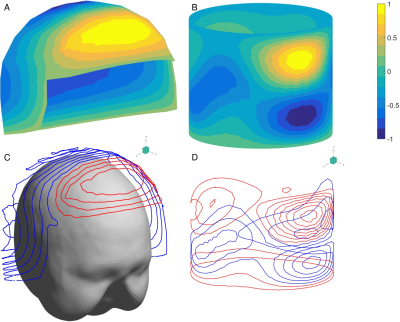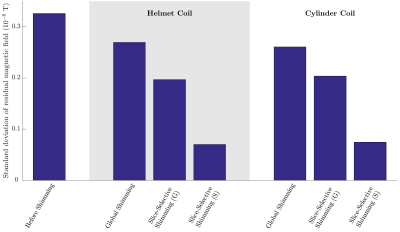1471
Designs of shim coils with distributed currents for 3T human brain magnetic resonance imaging1Neuroscience and Biomedical Engineering, Aalto University, Espoo, Finland, 2Institute of Biomedical Engineering, National Taiwan University, Taipei City, Taiwan, 3High-Field Magnetic Resonance, Max Planck Institute for Biological Cybernetics, Tübingen, Germany, 4Graduate Training Center of Neuroscience, IMPRS, University of Tübingen, Tübingen, Germany, 5Department of Medical Biophysics, University of Toronto, Toronto, ON, Canada
Synopsis
We propose single-channel head shim coils with either a helmet or a cylinder geometry. Shim current paths were designed by the stream function method with a realistic target field from a group of human subjects (n = 31). A smoothness constraint was included to decrease shim coil complexity. Helmet and cylinder shim coils with shim current amplitudes 4.2 and 6.9 A improved the standard deviation of residual magnetic field by approximately 17%, respectively.
Purpose
The spatial homogeneity of the static magnetic field, B0, is one of the most fundamental and common requirements for high-quality MRI. Living organism consists of various tissues with different magnetic susceptibilities. These susceptibility differences cause magnetic field distortions, hence, image artifacts and signal degradation. In a human head, the most significant susceptibility variations are due to the air–tissue interfaces around sinuses and auditory cavities1.
Here we propose shim coil designs to reduce the image distortions in human head by using the target field method with a stream function method2. The target fields are obtained from human subjects. We add a smoothness constraint in design in order to decrease the complexity of shim current paths and to obtain a shim coil that is more practical to build. We use simulations to calculate the performance of shim coil designs with both helmet and cylinder geometries.
Methods
We used stream function method in order to design shim current paths. In this method2, a scalar field stream function is defined on the coil surface such that curl of this field corresponds to the surface current. The magnetic field was then derived from a matrix-vector formulation3,4. Given a target magnetic field, the stream function was solved from a system linear equation. In order to obtain a spatially smooth stream function, we added a constraint that maximizes the spatial smoothness of stream function values. We measured the smoothness of the stream function values by a Laplacian operator. With the estimated stream function, we took its iso-contours in order to obtain a wiring pattern of shim current paths.
Off-resonance maps were measured from 31 participants using a dual-echo gradient-recall sequence (TE1 = 2 ms, TE2 = 4.46 ms) at 3 tesla (Skyra; Siemens, Erlangen, Germany) with 2-mm isotropic resolution after a 2nd-order global shimming. The phase accrued between two echoes was calculated at each image voxel by first removing the phase related to the coil sensitivity and then taking a weighted sum across receiver channels5. The phase wrapping was reduced by the BEST-PATH algorithm6,7. An off-resonance map was estimated by the ratio between the unwrapped phase map and the difference between two TEs. Off-resonance maps from all subjects were co-registered by FSL (FMRIB, Oxford, UK) to the standard brain MNI 305 atlas (FreeSurfer, 2007) by only translation and rotation. We used the average off-resonance map across all subjects for shim coil design.
Two different coil geometries were used: (i) a helmet geometry from a magnetoencephalography (MEG) system (MEGIN, Helsinki, Finland) and (ii) a cylinder geometry (15 cm radius; 25 cm height).
We calculated the sum of squared residual inhomogeneity and standard deviation of the residual inhomogeneity in order to measure the shimming performance. These metrics were separately calculated for global and slice-selective shimming.
Results
Figure 1 shows the stream function distribution and discretized shim current patterns on helmet and cylinder shim coil geometries with shim current of 4.2 A and 6.9 A, respectively. Both shim coil geometries showed similar performance and increased the magnetic field homogeneity significantly: The sum of squared residual inhomogeneity decreased by ~31% for both coil geometries and standard deviation of residual inhomogeneity decreased by ~17%. Shim coils design without a smoothness constraint had complex and irregular shim current distribution (not shown). Figure 2 shows orthogonal slices of the residual inhomogeneity after shimming using two shim coil geometries and different weighting of smoothness constraint. Significant increase in field homogeneity is achieved in all cases. Figure 3 shows the standard deviation of residual field inhomogeneity before and after global and slice-selective shimming. The shim current patterns designed for global shimming can be further optimized at selected slices.Discussion
We applied the target-field method with a stream function to design human head shim coil using realistic off-resonance maps. The coil design included a smoothness constraint in order to decrease the complexity of shim current patterns and to limit the shim current amplitude. Significant increase in magnetic field homogeneity is achieved with reasonable shim current magnitudes for both helmet and cylinder coil geometries in both global and slice-selective shimming cases. Both helmet and cylinder shim coils had similar shimming performance. However, the helmet shim coil ensured that the shim currents are close to the head surface in order to improve the magnetic field inhomogeneity efficiently. Moreover, as the front part of the shim coil is open, this design can be more user friendly for patients with claustrophobic concerns. It is also possible to provide visual stimulation during fMRI experiments since the eyes of the participants are not obscured.Acknowledgements
We appreciated helpful comments from Drs. Jason Stockmann, Thomas Witzel, and Aapo Nummenmaa. This work was partially supported by the Ministry of Science and Technology, Taiwan (103-2628-B-002-002-MY3, 105-2221-E-002-104), the National Health Research Institutes, Taiwan (NHRI-EX107- 10727EI), and the Academy of Finland (No. 298131).References
1. Koch K. M., Rothman D. L. & de Graaf R. A.Progress in Nuclear Magnetic Resonance Spectroscopy.2009; 54:69-96.
2. Pissanetzky S.Measurement Science and Technology.1992; 3:667-673.
3. Hoult D. I. & Deslauriers R.Journal of Magnetic Resonance, Series A.1994; 108:9-20.
4. Ungersma S. E., Xu H., Chronik B. A. et al.Magnetic Resonance in Medicine.2004; 52:619-627.
5. Luo J., Jagedeesan B. D., Cross A. H. et al.Neuroimage.2012; 60:1073-1082.
6. Schofield M. & Zhu Y.Opt Lett.2003; 28:1194-1196.
7. Bouwman J. G. & Bakker C. J.Magn Reson Med.2012; 68:621-630.
Figures


